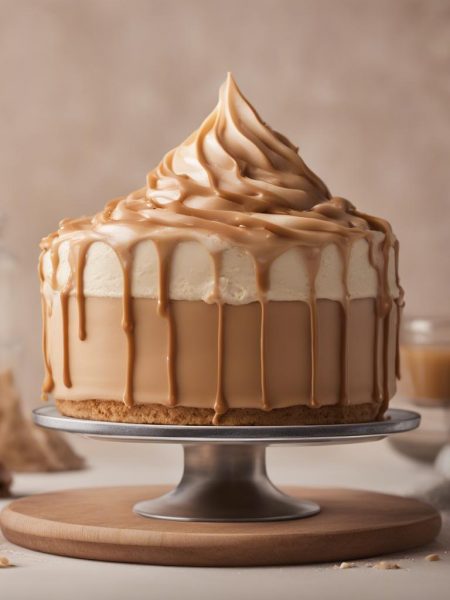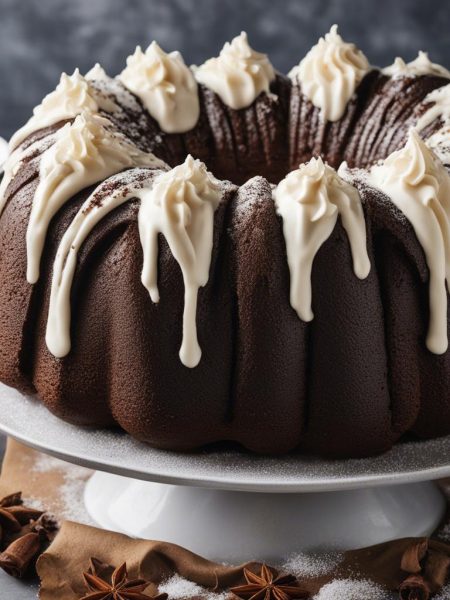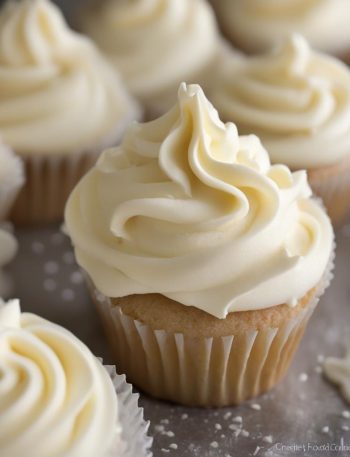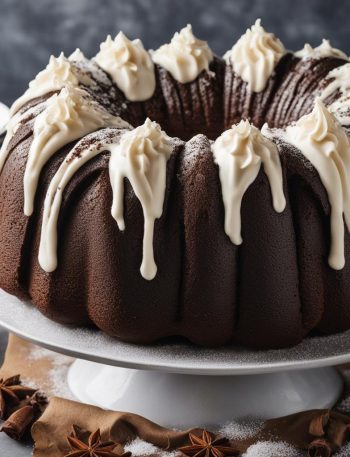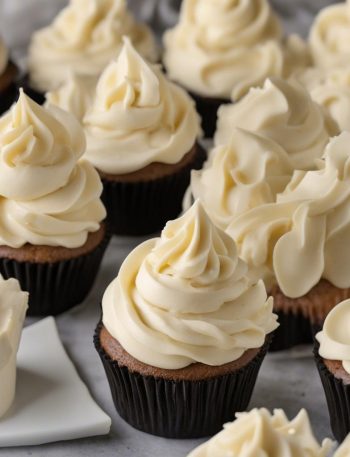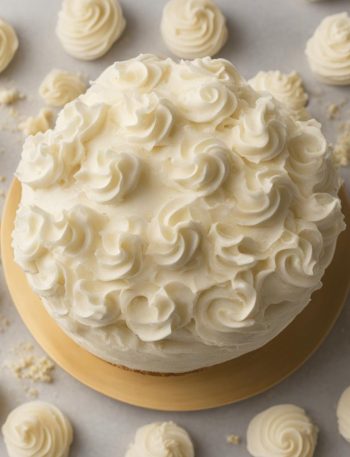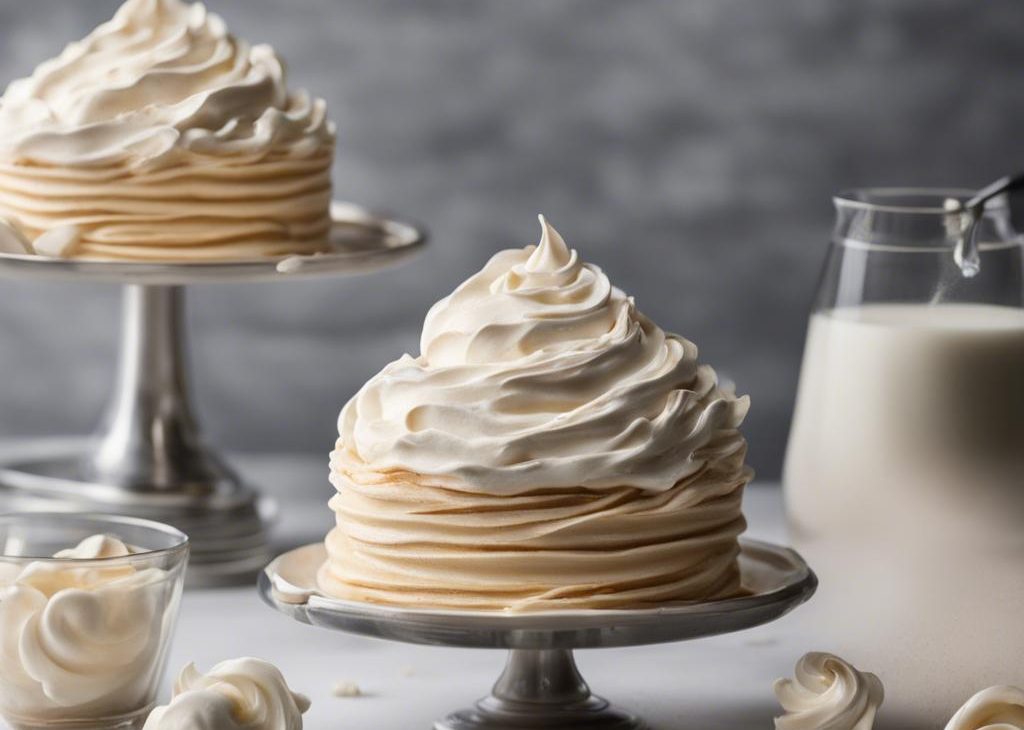
Made from 5 ingredients, this is perfect Swiss meringue buttercream. Written in easy terms with in-depth instructions and troubleshooting tips, this post teaches you how to make the best meringue buttercream even if you’ve failed before or if it’s your first try. This frosting is creamy, silky smooth, holds its shape beautifully, and the best part—and why everyone loves it—is that it’s not extra sweet like traditional American vanilla buttercream.
Do you want to master Swiss Meringue Buttercream (SMBC) but are too nervous to try it? I get it, the thought of making meringue as the base of a frosting sounds complicated, timely, and intimidating. Let me break down that barrier for you—this recipe is where you start.
What is Swiss Meringue Buttercream?
Swiss meringue buttercream joins other varieties—French and Italian—as a stable, not overly sweet frosting. The process for each is a little different, but the Swiss method is arguably the easiest. Swiss meringue buttercream is made from cooked egg whites and sugar, butter, and flavorings like vanilla and salt. Whip the cooked egg whites and sugar into stiff peaks, then slowly add the butter before adding flavors. It’s out-of-this-world creamy, extra smooth, and the perfect sweetness for any confection. The whipping process is long and where some trouble can start, including never reaching stiff peaks. The butter can also melt, leaving you with SMBC soup. Or you can over-whip everything into curdles.
It’s a little more complicated than my whipped frosting, but it’s worth it! Today I’m putting you on the right SMBC track, plus there’s usually a fix for everything—and I teach you how in this post.
This Swiss Meringue Buttercream Is:
- Made from 5 basic ingredients
- Silky smooth and buttery
- Thick and ultra creamy
- Perfect for piping or spreading
- Flavored with vanilla and a touch of salt
- Not cloyingly sweet like traditional frosting
Ingredients
Let me explain why each ingredient is important. Feel free to keep scrolling to the full recipe written below.
. It’s a faded horizontal image of cupcakes. Click on the play button in the center. Make sure any ad blockers are temporarily paused on your browser.
How to Make Swiss Meringue Buttercream
Here’s an overview of the steps. Full instructions available in the recipe below. Feel free to keep scrolling to the full recipe if you’d like!
A small egg separator is a helpful tool in this recipe.
Cook and whisk egg whites and sugar over indirect heat. When it’s ready, the mixture will be frothy on top and thin. (Below, right.)
What Are Stiff Peaks?
After several minutes of mixing, the meringue should form stiff glossy peaks. This means it forms stiff, smooth, and sharp points in the bowl or on the lifted whisk attachment.
Stiff peaks do not droop down.
After reaching stiff peaks, let the meringue cool for a bit, then beat in the butter 1 Tablespoon at a time.
Success Tip: Because butter needs to be on the cooler side, I don’t remove it from the refrigerator and cut it into Tbsp pieces until I start whipping the meringue.
Add vanilla and salt, then you’re done.
Buttercream is now deliciously creamy and smooth!
5 Helpful Tools
Troubleshooting Swiss Meringue Buttercream
How to Use It:
- Pipe it…
- As a filling for macarons or whoopie pies
- Instead of buttercream to decorate Halloween cupcakes.
- See “Yield” recipe note below for more ideas.
See Your Swiss Meringue Buttercream!

Perfect Swiss Meringue Buttercream Recipe
Description
This is vanilla Swiss Meringue Buttercream perfection. It's the ideal balance of sweet and creamy, without being as cloyingly sugary as American buttercream. (This is a far cry from how sweet that is!) Thick, sturdy, and perfectly pipe-able. This in-depth recipe sets you up for success on your 1st try.
Ingredients You’ll Need
Instructions
- . Make sure all the tools you are using are completely cleaned, dried, and grease-free. A quick wipe with a little lemon juice or white vinegar is very helpful.
- If you haven’t done so yet, separate the eggs first. Separate 1 egg white in a small bowl, then place the egg white in your heatproof mixing bowl. Repeat with the remaining egg whites. This way, if a yolk breaks in one of them, you don’t waste the whole batch.
- Whisk sugar into the egg whites, then set the bowl over a saucepan filled with just two inches of simmering water over medium heat. Do not let the bottom of the egg whites bowl touch the water. Whisk the whites and sugar constantly until sugar is dissolved and mixture has thinned out, about 4 minutes. The mixture will be thick and tacky at first, then thin out and be frothy white on top. To test that it’s ready, you can use your finger or an instant read thermometer. Lightly and quickly dip your finger (it’s very hot, be careful) and rub the mixture between your thumb and finger. You shouldn’t feel any sugar granules. If using a thermometer, the temperature should read 160°F (71°C).
- No need to let it cool down to start this next step—it’s important to begin mixing while it is still warm. Transfer mixture to the bowl of a stand mixer fitted with a whisk attachment (if you aren’t already using the metal bowl that comes with it). You can use a hand mixer instead, but this step takes awhile and your arm tires quickly. On medium-high speed, beat the mixture until stiff glossy peaks form and the meringue is no longer warm to the touch, at least 10-15 minutes. On particularly humid days, this has taken me up to 17-18 minutes. If it’s still not reaching stiff peaks, stop the mixer, place the bowl—uncovered—in the refrigerator for 10 minutes, then return to the mixer and continue beating until stiff peaks form. (This has always worked for me when it’s taking forever to reach stiff peaks.)
- If the bowl and meringue still feel warm, wait until both cool to room temperature (around 70°F (21°C)) before adding the butter in the next step. Feel free to place it in the refrigerator. A warm bowl and meringue will melt the butter.
- Switch the stand mixer to the paddle attachment. On medium-high speed, add the butter 1 Tablespoon at a time. Wait for the butter to fully mix in before adding the next Tablespoon. After all the butter has been added, turn the mixer down to medium speed and fully beat in the vanilla and salt, about 30 seconds.
- Your Swiss meringue buttercream should be thick, creamy, and silky smooth and is ready to use on any cake, cupcake, or other confection.
- If your meringue has separated, curdled, or is too thick at any point after you mix in all of the butter, place the mixture in your heat-proof bowl back over a pot of 2 inches of simmering water. Without stirring, let the edges of the meringue warm up and become liquid (the center of the meringue will still be solid), about 1-2 minutes. Remove from heat and return to the mixer. Beat meringue on low speed for 30 seconds, then switch to medium-high speed and beat until smooth, about 2 minutes. Works every time. If your mixture has become too thin and soupy after you add the butter, place the entire bowl in the refrigerator (covered or uncovered, doesn’t matter) for 20 minutes to cool down, then return it to the mixer and beat on medium-high speed until thickened. Any longer than this will solidify the butter, so only refrigerate in 20 minute spurts. If it’s still soupy, place back in the refrigerator for longer before re-whipping again. More troubleshooting tips in the post above.
Frequently Asked Questions
Provided you aren't allergic to any of these ingredients, yes. The eggs are cooked to 160°F (71°C), which is considered safe to eat for everyone including pregnant women and children. As always, use your best judgement and feel free to consult a Dr if you're concerned.
No, Swiss meringue buttercream does not crust or dry out like American buttercream can. That's why SMBC is excellent for creating the smoothest frosting detail on cakes and perfectly piped (yet still fluffy tasting!) designs.
Yes, Swiss meringue buttercream is stable at room temperature. Though if eating on a particularly humid day, keep your frosted confections in the refrigerator as close to serving as you can. You can use SMBC under fondant-topped cakes and confections, too.
Replace some (about 1 teaspoon) of vanilla extract with 1 teaspoon of another flavor extract such as lemon, coconut, orange, maple, or even 1 teaspoon of espresso powder. Taste, then add a touch more if desired. For potent extracts, like peppermint or almond, replace 1 teaspoon of the vanilla with just 1/2 teaspoon. For chocolate Swiss meringue buttercream, beat 8 ounces of pure melted and slightly cooled chocolate into the buttercream when you add the vanilla and salt. Make sure you're using pure baking chocolate (the 4 ounce bars) like Baker's or Ghirardelli brands found in the baking aisle.
Yes and it's best to tint SMBC with gel food coloring so you aren't adding a lot of extra liquid. Beat food coloring into the frosting on low speed after you add the vanilla extract and salt.
Yes. Swiss meringue buttercream is great left covered at room temperature for 1-2 days, but after that, refrigerate it for up to 5 days or freeze up to 3 months. If freezing, store in an airtight container, then thaw it at room temperature on the counter. Once completely at room temperature, about 72°F (22°C), place into the bowl of your stand mixer fitted with a paddle attachment and beat for 2-3 minutes until creamy again. If it separates or curdles, see troubleshooting tips below.

